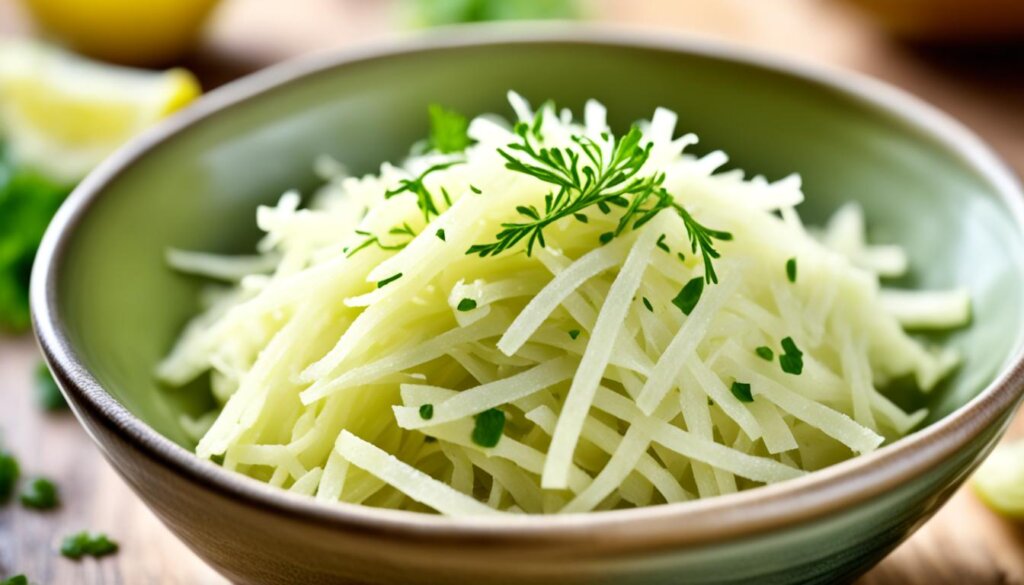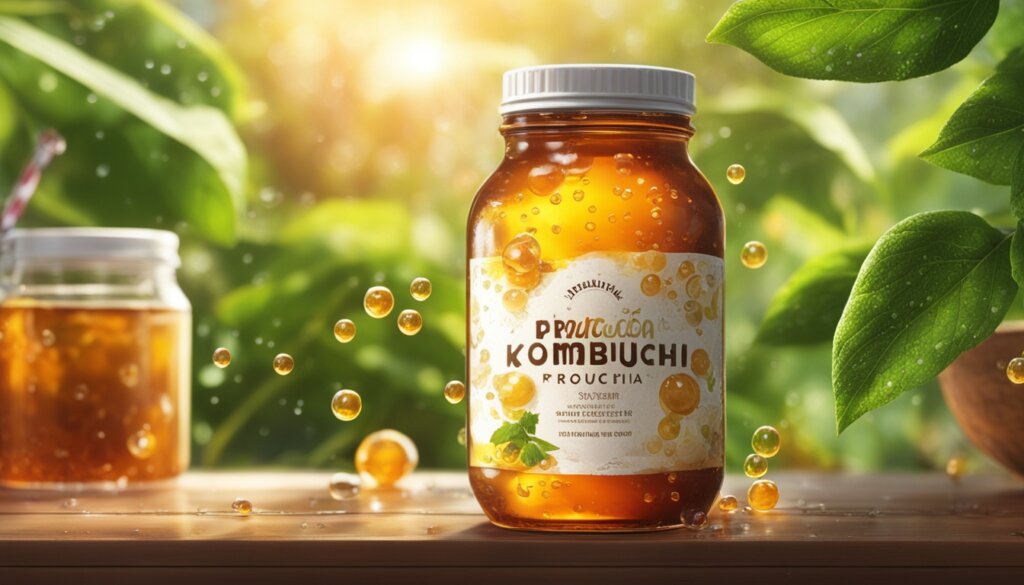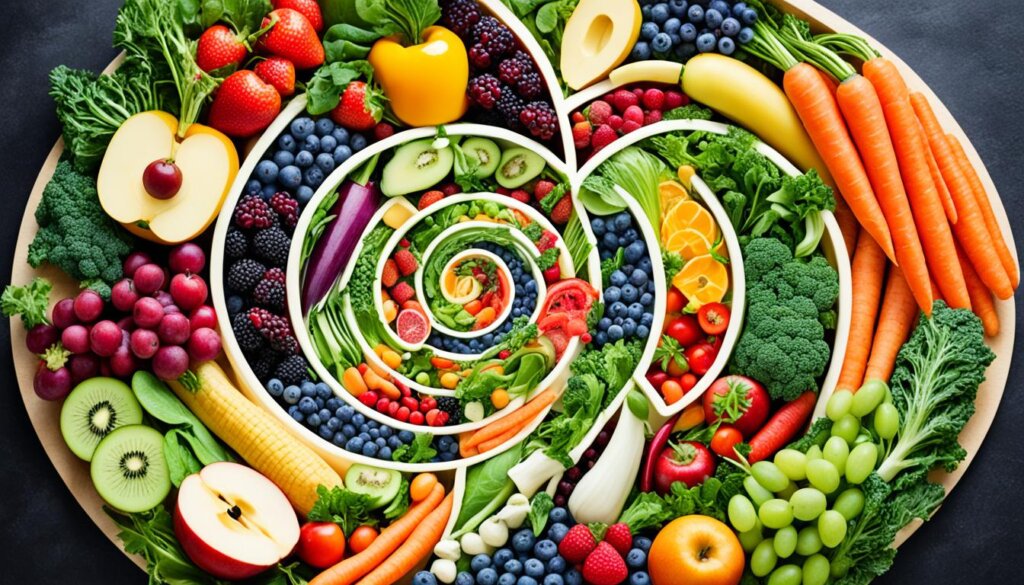FTC disclaimer: This post may contains affiliate links and we will be compensated if you click on a link and make a purchase.
Here’s a cool fact: eating foods like yogurt, kefir, and sauerkraut can make your gut healthier! These foods have probiotics, which are live microorganisms. They’re awesome for your body and mind.
Probiotics help with digestion and can make you feel less blue. They even help with your skin. Adding these foods to your diet is a tasty way to boost your gut bugs and feel good all over.
Key Takeaways
- Probiotic-rich foods like yogurt, kefir, sauerkraut, tempeh, and kimchi provide beneficial bacteria that support gut health.
- These fermented foods offer a range of nutrients and health benefits beyond just probiotics, including improved bone, heart, and immune function.
- Consuming a variety of probiotic-rich foods can help diversify your gut microbiome for optimal digestive and overall health.
- Choosing minimally processed, unpasteurized versions of these foods ensures you get the full probiotic benefits.
- Incorporating probiotic-rich foods into your meals and snacks is an easy and delicious way to boost your intake of gut-friendly bacteria.
Introduction to Probiotics and Gut Health
Probiotics are tiny organisms like bacteria and yeasts that are good for us. They mainly help our digestive system. These friendly bugs are key to keeping our gut healthy.
They do this by working in the diverse community of microorganisms in our intestines. Eating enough foods with probiotics can improve digestion.
It can lower inflammation, strengthen our immune system, and even help our mental health. So, adding probiotic-rich foods to our diet is a smart move for our overall health.
What are Probiotics?
Probiotics are beneficial live microorganisms, including bacteria and yeasts. They are helpful, especially for our digestion. These good bugs are essential for a healthy gut mix in our intestines. They help with our digestion, immune system, and even our mental well-being.
Benefits of Probiotics for Gut Health
Probiotics offer many good things for our gut. They can fight off or heal diarrhea from infections and medicines, make irritable bowel syndrome symptoms better, strengthen the immune system, and lower inflammation and allergies.
Eating foods full of probiotics, like kefir, kimchi, and yogurt, helps your gut bugs stay healthy. This in turn boosts your health in general.
Yogurt: A Classic Probiotic Powerhouse
Yogurt is a top source of probiotics. It’s made from fermented milk by helpful bacteria, such as lactic acid and bifidobacteria. These bacteria change milk’s lactose into lactic acid, giving yogurt its tangy taste.
How Yogurt is Fermented
The fermenting process turns ordinary milk into healthy yogurt. Lactic acid bacteria in the milk makes lactic acid. This is why yogurt is thick, creamy, and has a bit of a sour taste.
Nutritional Benefits of Yogurt
Yogurt is great for your bones, heart, and gut. It helps lower the chances of diabetes and some cancers. Even people who can’t have much lactose might do okay with it.
Choosing the Right Yogurt for Probiotics
Yet, not all yogurts help your gut. Make sure your choice mentions live and active cultures on the label. Every probiotic yogurt has its own mix of bacteria, affecting how well they work. Store-bought kinds are easy to find and come in many flavors, but they might have too much sugar.
Also, the way they’re made could lessen the health perks. Making your own lets you pick the ingredients and the good bacteria types you want.
Kefir: A Diverse and Potent Probiotic Drink
Kefir is a fermented milk drink that comes from adding kefir grains to milk. These “grains” are not really grains. They are cultures of bacteria and yeast. They make the milk into a potent probiotic drink. Kefir has many strains of good bacteria and yeast, more than yogurt.
Probiotic Strains in Kefir
The making of kefir gives it many probiotic strains. This includes lactic acid bacteria and yeast. Kefir’s mix of helpful bacteria and yeast is wider than yogurt’s.
Health Benefits of Kefir
Kefir is good for your health in a few ways. It can help your bones, improve your digestion, and fight infections. It’s also a solid choice for those who can’t have much lactose. That’s because a lot of the lactose gets broken down during the making process.
Sauerkraut: A Fermented Cabbage Delight
Sauerkraut is cut sauerkraut that has sat in lactic acid bacteria. People have loved it for a long time, especially in Eastern Europe. The sour, salty taste comes from the fermentation process.
Traditional Sauerkraut Fermentation
To make sauerkraut, you need cabbage and salt. This mix lets the lactic acid bacteria turn sugar into lactic acid. Eating sauerkraut is great for your gut because it’s full of probiotics.
Adding things like carrots, ginger, and fennel can make it taste different.
Nutritional Value of Sauerkraut
Sauerkraut is more than a probiotic. It’s also packed with fiber and vitamins like C and K. You’ll find iron, potassium, and eye health antioxidants in it too. A cup of sauerkraut has few calories and is a solid source of some essential vitamins.
For the best health benefits, choose sauerkraut that’s not pasteurized. This keeps the good bacteria alive.

Tempeh: A Nutty, Fermented Soy Treat
Tempeh is a firm patty made from fermented soybeans. It comes from Indonesia originally. Now, it’s known worldwide as a good source of protein instead of meat.
The fermenting process changes tempeh’s nutrition. It lowers phytic acid, so the body can take in more iron and zinc. Plus, some vitamin B12 is made during fermentation, which is rare in plants. This is especially good for people not eating meat, like vegetarians and vegans, who need this vitamin.
Nutritional Benefits of Tempeh
A 3-ounce serving of tempeh has 162 calories. It also has 15 grams of protein, 9 grams of carbs, and 9 grams of fat. It’s a good source of iron, calcium, riboflavin, niacin, magnesium, phosphorus, and manganese.
With 31 grams of protein in a cup, it’s a solid plant-based protein choice. Tempeh also lowers harmful cholesterol and offers antioxidant protection.
It helps with bone health and its calcium is well absorbed by the body. Yet, those allergic to soy or with thyroid problems should be cautious with tempeh.
How Tempeh is Fermented
Tempeh can be used in many ways. You can bake, steam, sauté, or marinate it for different meals. It’s best eaten within 3-5 days if fresh; for longer shelf life, try the pasteurized kind.
Tempeh is full of fiber, which helps your gut and keeps you regular. It’s also rich in antioxidants, great for the immune system, and fights inflammation.
Kimchi: A Spicy Korean Probiotic Favorite
Kimchi is a Korean side dish, spicy and fermented. It’s usually made with cabbage. Other veggies like radish can be used too. It gets its spicy flavor from red chili pepper, garlic, and ginger. The fermentation adds good bacteria like Lactobacillus that can help your gut.
Kimchi with cabbage is rich in vitamins K and B2, and iron. Its mix of probiotics and vitamins makes it a top-choice healthy food.
Traditional Korean Kimchi Preparation
To make kimchi, it takes 1–2 days at room temperature or longer in the fridge. If kept cold, it can last up to a year. Remember, it’s best to eat it within a week after opening for safety.
Health Benefits of Kimchi
A study found those who ate more kimchi, going from 60g to 300g daily, increased their healthy gut bacteria in 4 weeks. Research by ZOE and Stanford University showed that more fermented foods led to better gut health and less inflammation.
In the same study, people with the H. pylori bug improved by eating 100g of kimchi daily for 10 weeks. Their gut health got better, inflammation reduced, and sometimes the bug went away.
Additionally, those who ate kimchi had lower “bad” cholesterol and greater “good” cholesterol levels. This shows more benefits of enjoying kimchi.

Miso: A Versatile Japanese Fermented Paste
Miso is a seasoning from Japan, made by fermenting soybeans with salt and koji fungus. Other grains like barley, rice, or rye can be used in the process too. It’s key in dishes like miso soup, an important breakfast choice in Japan. Different types of miso have flavors ranging from white to brown.
Miso Fermentation Process
The making of miso involves a traditional fermenting technique. It can take a few weeks to several years. Longer fermenting, up to three years, makes the miso darker and stronger in taste. This long process gives miso a rich and complex flavor and has many health benefits.
Varieties of Miso
There are many styles and colors of miso, each with a unique taste. White miso is sweet and mild, red miso is salty and strong. Yellow miso is in the middle, offering a balanced taste. The darker and longer-fermented miso has a deeper, nutty taste.
Nutritional Value of Miso
Miso paste has about 56 calories in each ounce and offers 7 grams of carbs, 2 grams of fat, and 3 grams of protein. It’s high in sodium and has nutrients like manganese and vitamin K. Miso is a complete protein, with all essential amino acids.
A tablespoon of miso (15g) has 30 calories, 2.0g protein, and more. This includes iron, zinc, and folate.
Miso is used in many Japanese and international dishes for its health and flavor benefits. It’s known for being probiotic and rich in nutrients. This makes it a great part of a healthy diet.
Kombucha: A Fermented Tea Drink
Kombucha is a tea drink that people love, especially in Asia. It’s made by mixing black or green tea with bacteria and yeast. This mix ferments the tea and makes it a bit fizzy and tart.
Some studies say kombucha might lower the risk of some diseases, like cancer and diabetes. But, we still need more studies to be sure. What we do know is that as a fermented drink, it’s good for the gut because it adds healthy bacteria.
What is Kombucha?
Kombucha is a special tea that’s been around for a while but has really become popular lately. To make it, you mix a sweet black or green tea with a SCOBY. This scoby is a community of bacteria and yeast. It turns the tea into a drink that’s a little fizzy and sweet-tart. Plus, it’s full of good stuff like organic acids, vitamins, and probiotics.
Potential Health Benefits of Kombucha
Some think the probiotics in kombucha can help with your mood and keep your heart healthy. This fizzy tea has natural compounds that might keep your liver safe and help manage blood sugar. But, we’re not sure yet.
It’s wise to enjoy your kombucha in a healthy way since little is known about the risks from making it at home.
There’s talk that kombucha could keep you from getting sick and stop constipation. But, we don’t have strong proof of these benefits. Some folks have had tummy troubles, gotten sick, or had allergies from drinking it. If you make it at home the wrong way, it could also be harmful because of bad bacteria or even lead.
On the whole, kombucha is likely good for your gut because of the probiotics. However, to really say what health benefits it offers, we need more studies.
It’s always smart to drink kombucha in moderation. This is even more important if you have to watch your sugar, like people with diabetes. Enjoying kombucha as part of a varied diet can be a good choice.

Pickles, Buttermilk and Natto
Pickles: A Crunchy Probiotic Snack
Pickles are not the only probiotic-rich foods. Many other fermented foods help our gut. Pickles, known as fermented cucumbers, are crunchy and full of probiotics. The process of making them creates helpful lactic acid bacteria. These bacteria are good for our digestion.
Traditional Buttermilk: A Fermented Dairy Drink
Don’t forget about traditional buttermilk. It’s the liquid left after churning butter. It’s a fermented dairy drink with probiotics, not like the regular cultured buttermilk you find in stores.
This kind of buttermilk is more common in places like India, Nepal, and Pakistan. It’s packed with vitamins and minerals. You get vitamin B12, riboflavin, calcium, and phosphorus from it.
Natto: A Unique Japanese Fermented Soybean Food
Natto is a special Japanese food from fermented soybeans. It’s full of a bacteria called Bacillus subtilis. This food is great for your gut. Plus, it has protein, fiber, and vitamin K2.
Eating natto might make women’s bones stronger after menopause. This helps with bone and heart health.
Cheese: A Surprising Source of Probiotics
Many may not see cheese as a probiotic food. Yet, some kinds can offer good bacteria. Semi-hard cheeses such as cheddar, mozzarella, and gouda, and cottage cheese, might have more probiotics.
Cheesemakers are finding ways to keep probiotics alive as cheeses age. This makes cheese a nutritious choice, with protein, vitamins, and minerals like calcium and zinc. Eating probiotic-rich cheeses might bring extra health perks over regular cheese.
Types of Cheese with Probiotics
Not all cheeses are alike in probiotics. Yet, some are good for your gut. Semi-hard cheeses such as cheddar, mozzarella, and gouda often have live cultures. Also, cottage cheese could be a fine probiotic source. Cheesemakers keep looking for ways to keep these good bugs around.
Nutritional Benefits of Probiotic Cheeses
Cheese is top-notch for protein, vitamins, and minerals. Adding probiotics makes it even better for your health. Probiotic and key nutrients in cheese can help your gut health, immune system, and maybe even heart health and weight. Remember, always enjoy probiotic cheeses in small, balanced amounts.
Probiotic-rich Plant-Based Foods
Probiotic-rich foods don’t only come from dairy or soy. Many plant-based choices can offer good gut bacteria. For instance, green olives are brined naturally, which makes Lactobacillus. This is a type of healthy bacteria. Apple cider vinegar comes from fermented apple cider. It includes the “mother,” which has helpful proteins, enzymes, and bacteria. Sourdough bread is also fermented. It contains probiotics from its long process and can help your gut.
Green Olives: A Briny Probiotic Treat
Green olives get their briny flavor from a natural fermentation. This process creates lactic acid bacteria, a type of probiotics. So, eating green olives can add good gut bacteria.
Apple Cider Vinegar: A Fermented Gut-Friendly Drink
Making apple cider vinegar involves fermentation. The result is a drink with the “mother.” This includes proteins, enzymes, and beneficial bacteria. Adding this to your diet can help your gut stay healthy.
Sourdough Bread: A Probiotic-Packed Loaf
Sourdough bread goes through a long fermentation. This process with a starter culture boosts nutrients and grows good gut microbes. It’s an excellent choice for those wanting probiotics from plant sources.
Incorporating Probiotic Foods into Your Diet
Picking top-notch probiotic foods is key. Choose items that say they have live cultures. Steer away from over-processed or pasteurized ones since the heat can kill the good bacteria.
Tips for Choosing High-Quality Probiotic Foods
Selecting the right probiotic foods is vital. Opt for those that are not heavily processed, have live cultures. This way, you’re sure to get the most out of these foods. Stay away from options that are highly pasteurized or heat-treated, as they might not contain beneficial bacteria.
Creative Ways to Add Probiotic Foods to Your Meals
It’s easy to include probiotic-rich foods in your meals and snacks. Add yogurt, kefir, or pickled vegetables to your meals. Include miso paste in soups or dressings. Drink kombucha or have some sourdough bread. Being a bit inventive helps you add more probiotics to your meals, boosting your gut health.

Conclusion
Probiotic-rich foods support a healthy gut microbiome. This brings many benefits. Probiotics are live bacteria and yeasts. They help our digestive system. You can find them in yogurt, kefir, sauerkraut, and kimchi. These foods are both tasty and good for you.
Eating probiotic-rich foods often is good for your digestion. It boosts your immune system and can even help your mood. Natural foods like yogurt and sauerkraut are better than supplements. Adding these foods to your diet is an easy way to take care of your gut and body.
Choose from dairy, veggies, or plant-based probiotics. Adding different types of probiotic-rich foods to your diet is simple. It gives your body the good bacteria it needs to be healthy. Make meals exciting and healthy with these choices.
FAQ
What are probiotics and how do they benefit gut health?
Probiotics are tiny, live organisms including bacteria and yeasts. They help our health, especially the digestive system. They’re good for us because they keep a healthy mix of microorganisms in our gut. This helps us digest food better, fight off bad stuff, and maybe even makes us feel happier.
What are some of the best probiotic-rich foods?
The best probiotic foods are yogurt, kefir, sauerkraut, kimchi, miso, tempeh, and kombucha. These are all fermented. They have good bacteria and yeast that help our gut stay healthy.
How is yogurt a good source of probiotics?
Yogurt is made from milk and good bacteria, like lactic acid bacteria. This bacteria changes milk sugar to lactic acid, giving yogurt its tangy taste. Besides tasting good, yogurt helps our bones, heart, and stomach.
What makes kefir a diverse and potent probiotic drink?
Kefir is a drink made by adding kefir grains to milk. These ‘grains’ are really cultures of bacteria and yeast. This mix makes a strong drink with a lot of different good bacteria and yeast in it.
What are the probiotic benefits of sauerkraut?
Sauerkraut is cabbage that’s been fermented by good bacteria. This makes it taste tangy and salty. It has lots of fiber, vitamins, and antioxidants, which are great for you.
How does the fermentation process affect the nutritional value of tempeh?
Tempeh starts as soybeans and ends up as a firm patty after fermenting. Fermenting cuts down on stuff in soybeans that stop our bodies from using some minerals. It even adds some vitamin B12, important for some diets.
What are the health benefits of kimchi?
Kimchi’s a Korean dish, spicy and made from vegetables. Fermented, it makes a lot of good bacteria. It’s also full of important vitamins and minerals, making it a healthy, probiotic food.
What are the different varieties of miso and their nutritional value?
Miso is from Japan and made by fermenting soybeans with salt and koji fungus. It comes in different colors, each offering protein, fiber, and vitamins. Some studies think it might help protect us from certain health problems.
What are the potential health benefits of kombucha?
Kombucha is a tea drink that’s fermented, found worldwide. The process makes it a little fizzy and tart. It might lower the chances of getting cancer or diabetes. But, we need more studies to be sure.
What are some other probiotic-rich foods besides dairy and soy-based options?
Besides dairy and soy, you have plant-based options for probiotics. Green olives, apple cider vinegar, and sourdough bread are good examples. Their fermentation helps good bacteria grow in our gut.
How can I incorporate more probiotic-rich foods into my diet?
For the best probiotics, choose natural, high-quality foods. Check the label for live cultures. You can eat these foods at any meal, or try things like miso soup or a slice of sourdough for a snack.








